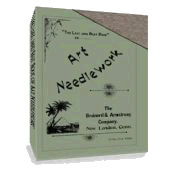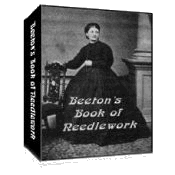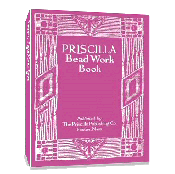[]Subscribe To This Site
Victorian Portieres
Victorian Portieres – we all have seen them and when we do, it conjures up images on ladies in long beautiful dresses and men with top hats, sitting in a parlor, chatting. Portieres, or door hangings, were used extensively throughout the Victorian era as a way to keep heat in a room and cold drafts out. Even though gas heat became available making portieres obsolete, Victorian ladies continued to use them as a decorating option.
Here is some information that was written for Victorian ladies in 1880 describing how to make decorative portieres.
How to Make a Aesthetically Pleasing Victorian Portiere
Portieres are more easy to manage than window curtains, they are usually not so long, and the light is always upon them; they are however treated on much the same principles.A number of horizontal bands will often look well for a door curtain; they should be of varying and well proportioned widths and of well-assorted colors. Roman scarves, real ones, and Moorish rugs will suggest good horizontal arrangements.
It is best to have a prevailing color, even if used in different shades and tones, using contrasting colors in narrow lines to border and enliven the broader bands. A handsome pattern worked on one or two of the bands will have a very good effect. It will be best in monochrome or in applied work of one color, edged with another. If the curtains are to be seen on both sides, as when they take the place of folding doors, they may want a little ornament on the side of the smaller room. It should be distinctly subordinate to the richer side. For instance, a red curtain with bands of black velvet embroidered in dark gold color, and narrow lines of gold color, brighter red, or perhaps deep blue, may have the reverse of plain red, with the rich pattern repeated in outlines of black.
For a curtain that is to be drawn over a door, a simpler treatment will be better — a repeated pattern all over it, or sprays of several sizes with a border of line patterns. A great deal of the finished effect of this, and indeed of all decorative needlework, depends on the apparently unimportant lines and borders with which the patterns are bounded and kept together. No directions can be given for them; they require a sense of proportion and feeling of fitness in the worker. Often they have to be put in after the work is otherwise finished; a thick line and a thin one, a little zigzag or herringbone between two lines, a row of dots or sloping stitches beside a line, will often make a marvelous difference to the finish and completeness of a pattern which without them gave a vague dissatisfaction.
These lines sometimes serve to give a balance of color that was wanting without them. Speaking very generally, middle tints of the ornament will serve for the color, but if, as happens sometimes, the color of flowers is felt to be a little too strong in the general effect, a few stitches of their color in the bordering lines between or beside, say the green of the leaves, may greatly improve matters. Lay some threads of the worsted or silk you may be using on the cloth beside the pattern, and you will readily judge of the effect.
A perpendicular arrangement of the ornament may be used sometimes for door curtains, though with caution. A dark blue curtain may have a pattern of oranges, leaves, and flowers worked in crewels. The orange being a good deal conventionalized in form already, by being made into an upright running pattern, and it being of more importance to make an harmonious decoration than a faithful portrait of the tree, the fruit must be conventionalized in color into a golden brown or a dim yellow, with a green one here and there. The leaves must be a brownish green; two shades will be enough, the darker of which will serve also for the stems. The flowers must be put in sparingly in a very yellow-white, and the yellow stamens and greenish buds should be made much of. The fruit must not be shaded, and the stitches should be upright in the middle, curving a little towards the top and bottom from the outside. Except in the case of an orange being seen end-ways, so that eye or stalk comes in the middle, when the stitches must be directed towards the center, the shape of the fruit will quite sufficiently convey the idea of roundness.
This will be a very rich decoration, yet notice how few colors are needed for it: one shade of yellow-brown, three of green, with a little white and bright yellow, which may be in filosel, are all that is needed. It is safe to assure you that a whole shopful of varied hues will not produce so good a decorative effect as these six, skillfully used in flat tints.
A handsome doorway curtain may be made of a dull gold-colored cloth, with a border all round like a carpet, of a reddish-pink, rather pale, with a conventional leaf pattern worked on it in dark brown, which must also edge the border. On the lower part of the curtain, springing from the border, may be three or four upright sprays of very conventional flowers, the leaves dark brown, and the flowers pink with brown centers and outlined in brown; the leaves may be veined with pink.
Another device for curtains that take the place of folding-doors, is two shades of green silk sheeting, large flowers worked on the dado of the darker sheeting and a single large spray of the flowers worked above the dado on each side of the opening of the curtains; some lighter sprays at the top of each curtain.
Drapery, Page 1 Page 2 Page 3
Return to top of Victorian Portieres Page
Return to Victorian Home Decor page.
Return from Victorian Draperies page to Home.



 433 pages!
433 pages!

